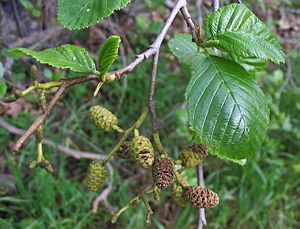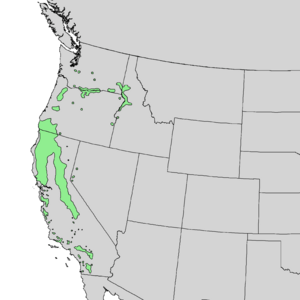White alder facts for kids
Quick facts for kids White alder |
|
|---|---|
 |
|
| Leaves and "cones" of the white alder | |
| Conservation status | |
| Scientific classification | |
| Genus: |
Alnus
|
| Species: |
rhombifolia
|
 |
|
| Where the white alder grows naturally | |
The white alder (Alnus rhombifolia) is a type of alder tree. It grows naturally in western North America. You can find it from British Columbia and Washington in the north, all the way east to western Montana. It also grows southeast into the Sierra Nevada mountains and south through parts of California.
This tree likes to live near water, in places like riverbanks or stream sides. It can grow at different heights, from about 100 meters (330 feet) to 2,400 meters (7,900 feet) above sea level. The white alder is often found in chaparral and woodlands, mountain areas, and temperate forests.
Contents
About the White Alder Tree
The white alder is a medium-sized deciduous tree. This means it loses its leaves every year. It usually grows to be about 15 to 25 meters (50 to 80 feet) tall. Sometimes, it can even reach 35 meters (115 feet)!
Leaves and Bark
The bark of young white alder trees is smooth and light gray. As the tree gets older, its bark becomes scaly. The leaves grow one after another along the branch. They are shaped like a diamond or a narrow oval. Each leaf is about 4 to 10 centimeters (1.5 to 4 inches) long and 2 to 5 centimeters (0.8 to 2 inches) wide. The edges of the leaves have small, fine teeth. The underside of the leaves is a bit hairy.
Flowers and Seeds
The white alder's flowers grow in long, hanging clusters called catkins. The male catkins are thin and yellowish, about 3 to 10 centimeters (1 to 4 inches) long. They grow in groups of two to seven. The tree is pollinated in early spring, even before its leaves appear.
The female catkins are shaped like an oval. When they are fully grown in autumn, they are about 10 to 22 millimeters (0.4 to 0.9 inches) long. They look a bit like small conifer cones. The tree's small, winged seeds spread out during the winter. The old, woody, blackish "cones" can stay on the tree for up to a year after the seeds are gone.
Special Abilities
The white alder is very similar to the red alder. One main difference is that the white alder's leaf edges are flat, not curled under. Like other alders, the white alder can fix nitrogen. This means it can take nitrogen from the air and turn it into a form that plants can use. This ability helps the tree grow well even in poor soils.
Traditional Uses
Some Native American tribes used the white alder. They used it for different health needs, including treatments for women's health.


